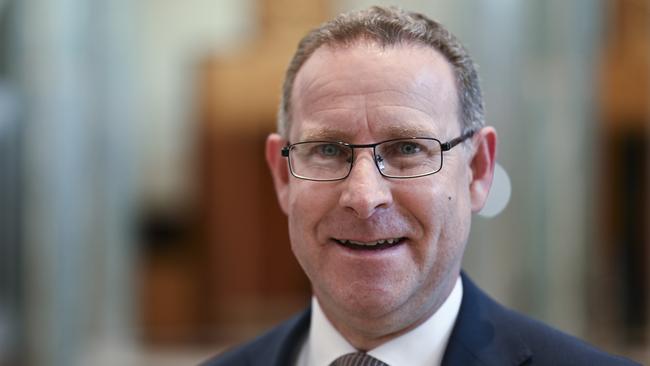
Higher costs of energy, rent, insurance and interest rates, he says, mean that 43 per cent of small businesses are not breaking even.
Looking ahead to next year, as the economy slows in the face of higher interest rates, he warns that they will struggle further as they face a “pipeline” of new regulation, including the Albanese government’s strict new industrial relations laws.
At the same time, they will have to deal with the removal of the small business exemption from the Privacy Act, and new “positive duties” under the Human Rights Commission.
The federal government’s latest mid-year economic forecast, released on Wednesday, paints a rosy picture of the Treasury benefiting from higher than expected revenues of $67bn over the four-year forward estimates period, which could result in another surplus being reported for the current financial year.
But underneath the stronger than expected fiscal and economic picture are the combined strains of higher costs and more regulation across the board, which will play out for a much tougher year for business as the economy slows in 2024.
The latest mid-year forecast predicts the economy will slow from a real rate of 3.1 per cent in the financial year to June this year, to 1.75 per cent in the financial year to June 2024, while unemployment will rise from 3.6 per cent last financial year to 4.25 per cent in 2023-24.
While the growth rate is higher than the 1.5 per cent rate expected in the May budget, it still shows a significant slowdown.
Achterstraat says small businesses in Australia are “feeling the pinch against the backdrop of rising energy, rent, insurance and borrowing costs”.
“With inflation expected to remain sticky into 2024, this is bad news for small businesses who will need to endure continued cost-of-living pressures, and an increased cost of doing business,” he says.
Next year, he says, will see a “significant pipeline of increased regulation that small business will need to absorb, including significant changes to the Fair Work Act, a revamped skilled migration policy, the removal of the small business exemption from the Privacy Act, and new positive duties under the Humans Right Commission”.
Dealing with the impact of the federal government’s new workplace relations system is now one of the biggest concerns facing small business.
“The shake-up has been reported as the greatest risk to small business into the new year with radical changes made to casual workers and independent contractors – two key planks of the small business workforce,” Achterstraat says.
The Business Council of Australia, which is also worried about the impact of the new industrial relations laws, says the mid-year forecast shows that “businesses are doing the heavy lifting” when it comes to Jim Chalmers’ budget repair story.
The fiscal picture for the current financial year has been boosted by an extra $17.2bn, roughly half coming from households and half from business, with the higher than expected iron ore prices playing a significant role.

But BCA chief executive Bran Black warns that the road ahead for business will be a lot tougher, with the new “productivity-killing” industrial relations laws making it “harder not easier to do business and create jobs”.
Business concerns about 2024 are evident in the latest NAB survey, which found business confidence at its lowest level since 2012 (outside of the Covid-affected period).
“We are concerned about an even more difficult 2024 unless the government reshapes its business agenda, eases the burden of regulation and puts in place more competitive settings,” Black says.
“MYEFO predicts slower growth in the economy this year, weaker jobs growth and higher unemployment while cost-of-living pressures on households get worse, which is exactly why the government needs to have a more pro-business and investment agenda.”
Black says the luck that Australia has seen in recent years, with continued strong commodity prices playing into the fiscal and economic outlook, will eventually run out.
“To drive economic prosperity, we need a genuine productivity agenda,” he says.
But while the issue of falling productivity has long been debated, the new IR laws will exacerbate the problem.
The fact that the economy has held up a lot better than many were expecting a year ago is good news, as is the fact that the federal government has opted to use much of the higher than expected revenue gains to reduce debt.
But the question is whether the combination of luck (from continued strong commodity prices) and special factors – such as high levels of immigration – will continued to provide a tailwind for the economy next year as regulatory imposts on business rise.
The Australian Chamber of Commerce and Industry also raised concerns about the advent of the new industrial relations laws in its response to the MYEFO statement on Wednesday.
“What’s missing from the government’s agenda is a focus on productivity,” says ACCI chief executive Andrew McKellar, who also noted corporate Australia’s contribution to the budget.

“The government is introducing complex, productivity-sapping industrial relations changes that choke productivity and drive up costs for businesses and consumers. The government is trying to grow wages while expanding the regulations it places on business, increasing bureaucracy and stunting business growth.
“You can’t rely on business to keep paying the bills if you’re tying one arm behind its back with over-regulation and industrial relations mismanagement.”
The good news on the revenue front is the extra money from business and people paying more tax due to bracket creep, which has helped paper over the deeper structural pressures on the budget.
As AMP economist Shane Oliver points out, the level of government spending as a share of GDP is expected to rise steadily over the decade ahead – well ahead of the 24.8 per cent of GDP before Covid.
He says interest costs have emerged as the biggest single pressure on the budget in the years ahead.

Interest payments are expected to rise by almost 12 per cent a year over the decade from 2023-24 to 2033-34 – much higher than the 9 per cent expected in the May budget.
This is followed by the NDIS, where costs are expected to rise by 10 per cent a year over the decade, with spending on hospitals, defence, medical benefits and age care all expected to increase at about 6 per cent a year.
In short, the picture ahead is one of increasing government spending in the years ahead, with business – which has helped to deliver a second potential surplus – heading into 2024 facing significant headwinds.
One factor that continues to defy logic is how the iron ore price has remained strong despite the slowdown in China’s economy.
Will the slower economy in Australia’s biggest trading partner eventually flow through into lower iron ore prices, or will Australia’s luck in that area continue to hold?
Measures announced in the statement also make it clear that housing will be a one of the key issues in the 2025 election.
As Oliver points out, last financial year saw an estimated record 510,000 new arrivals, compared with a projected 180,000 in the March budget of 2022.
The latest figures show that net migration is expected to come in at 375,000 this financial year, up from the May budget forecast of 315,000, despite the federal government’s new stricter visa policies.




Small businesses should brace for a “perfect storm of costs” in 2024, says Council of Small Business Organisations Australia chief executive Luke Achterstraat.